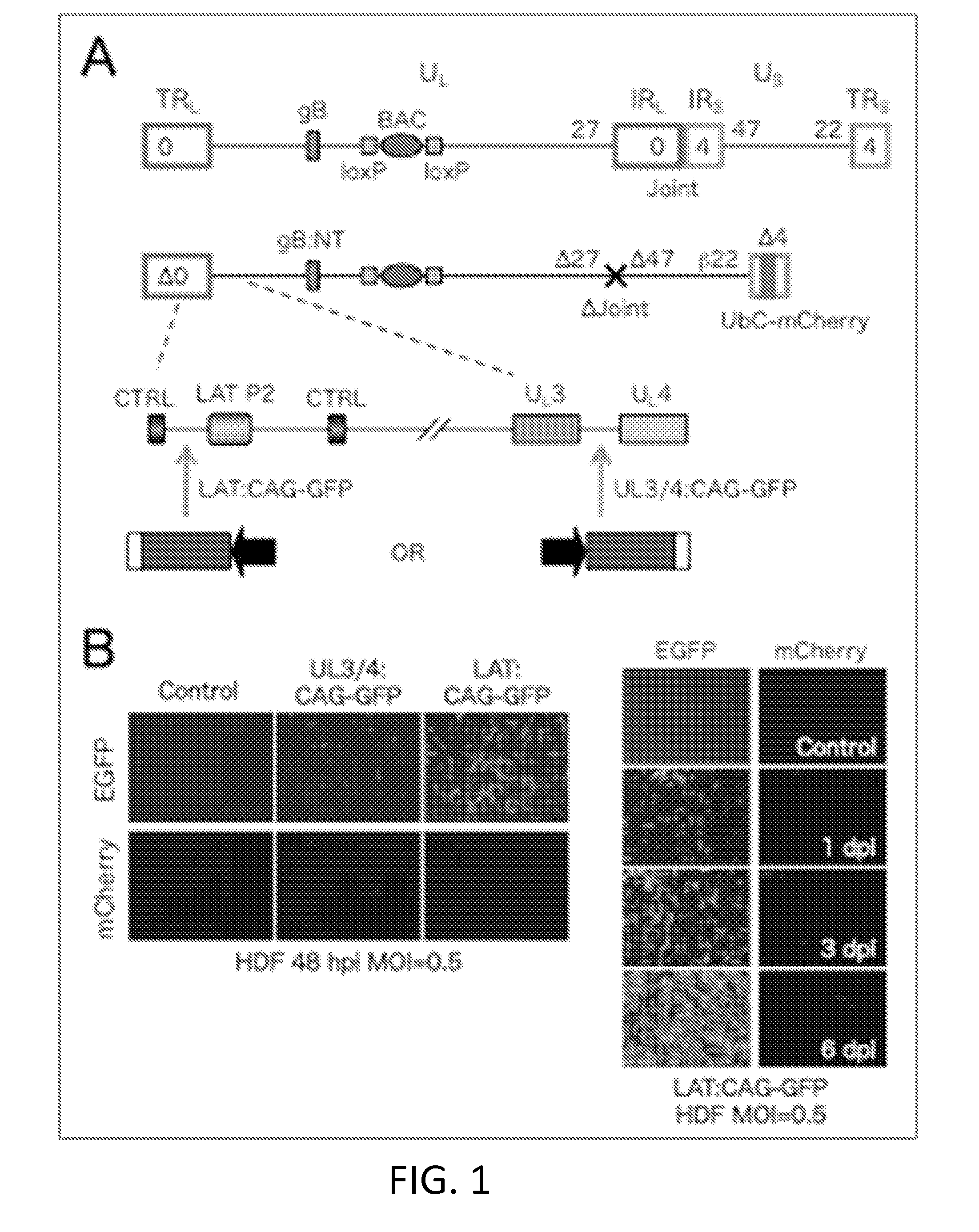Non-toxic hsv vectors for efficient gene delivery applications and complementing cells for their production
- Summary
- Abstract
- Description
- Claims
- Application Information
AI Technical Summary
Benefits of technology
Problems solved by technology
Method used
Image
Examples
example 1
[0081]This example describes the development of a complementing cell line for replicating and producing the inventive HSV vectors.
[0082]Several of the immediate early (IE) genes of HSV are essential for virus replication, but these and other IE genes have toxic effects in a variety of cell types. While the removal of these genes prevents vector toxicity, the essential products must be provided in order to produce infectious viral particles. A novel cell line, based on U2OS human osteosarcoma cells, was engineered to conditionally express the essential IE genes ICP4 and ICP27. These genes were introduced under the control of their cognate viral promoters by retrovirus-mediated insertion. As such these genes may remain silent until HSV infection delivers the HSV tegument protein VP16 to the nucleus where it promotes high-level expression of the integrated ICP4 and ICP27 genes by activation of their promoters. Thus, prior to HSV infection, these genes can be stably maintained in the en...
example 2
[0085]This example describes an embodiment of a HSV vector comprising a genome comprising a transgene inserted within a LAT gene region, wherein the vector does not express ICP0, ICP4, ICP22, ICP27, and ICP47 as immediate early genes.
[0086]The vector genome (FIG. 1A) contains a Cre-removable bacterial artificial chromosome (BAC) cassette in the UL37-UL38 intergenic region allowing propagation and manipulation in bacteria. It is deleted for the non-essential internal repeat region (Joint, 14 kb) separating the UL and US segments to provide space for transgene insertion and increase vector stability. The vector is replication defective due to deletion of the ICP4 and ICP27 genes, and is additionally deleted for the toxic IE gene ICP0 and the promoter and start codon of the ICP47 IE gene; the remaining toxic IE gene, ICP22, is controlled by an ICP4-dependent (early, 13) promoter, so as to express ICP22 during the “early,” rather than the “immediate early,” phase of HSV gene expression ...
example 3
[0088]This example lists the structure and properties of various HSV vector constructs.
vector featuremCherryGFPICPICPICPICPICPHDFexpressionexpressionVirus04*222747LATUL41UL3-4toxicity****JΔβββ3βΔββΔpwtwtwt+++++n / aJΔNI3ΔΔββΔpwtwtwt+++−n / aJΔβββ4βΔββΔpwtwtEF1α-GW+++++n / aJΔNI4ΔΔββΔpwtwtEF1α-GW+++−n / aJΔNI5ΔΔβΔΔpwtwtwt+−n / aJΔNI6ΔΔβΔΔpwtwtEF1α-GW=−n / aJΔNI6-EF1αGFPΔΔβΔΔpwtwtEF1α-GFP+−−JΔNI6-CAGGFPΔΔβΔΔpwtwtCAG-GFP+−−JΔNI7-GFPΔΔβΔΔpCAG-GFPwtwt+−+++JΔNI7-EF1α2GFPΔΔβΔΔp2EF1α2-GFPwtwt+−+JΔNI7-ΔΔβΔΔp2EF1α2-wtwt???miR302GFPmiR302 / 367-GFPJΔNI8ΔΔβΔΔpwtΔwt−−n / aJΔNI8-GFPΔΔβΔΔpCAG-GFPΔwt−++++†Δ = deletion; β = converted to early expression kinetics; Δp = promoter and start codon deleted1 CAG promoter2Contains EF1α first intron following the EF1α promoter*All have the same mCherry expression construct in the deleted ICP4 locus** In HDF (human dermal fibroblasts) at 3 dpi
PUM
| Property | Measurement | Unit |
|---|---|---|
| Time | aaaaa | aaaaa |
| Digital information | aaaaa | aaaaa |
| Pharmaceutically acceptable | aaaaa | aaaaa |
Abstract
Description
Claims
Application Information
 Login to View More
Login to View More - R&D
- Intellectual Property
- Life Sciences
- Materials
- Tech Scout
- Unparalleled Data Quality
- Higher Quality Content
- 60% Fewer Hallucinations
Browse by: Latest US Patents, China's latest patents, Technical Efficacy Thesaurus, Application Domain, Technology Topic, Popular Technical Reports.
© 2025 PatSnap. All rights reserved.Legal|Privacy policy|Modern Slavery Act Transparency Statement|Sitemap|About US| Contact US: help@patsnap.com



